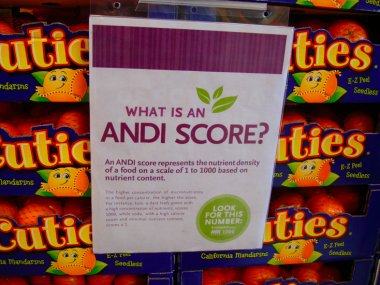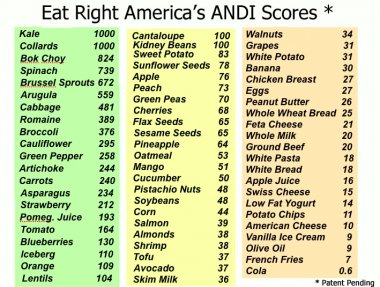Future Now
The IFTF Blog
Apples 67, Oranges 109—Fight!
Kale, ANDI-1000. Broccoli, ANDI-376. Carrots, ANDI-240. It seems so familiar, yet so bewildering. What are these signs, and why is the answer on the tip of my tongue as I roll through the produce section of my local Whole Foods? Should I hunt around for some explanatory sign? Should I Google it?
It's not the ONQI (which we've covered previously as a signal), and it's more complicated than starring or traffic light systems… I recall reading something about this lately…
Ah, yes. The Eating Right America Aggregate Nutritient Density Index, a genuine nutritional scoring system, created by Dr. Joel Furhman (the first such numeric ranking to appear in a supermarket near me, what a thrill to this food & health geek)! And as of late last month Whole Foods began adding it to it's signage for whole foods, specifically produce. I found the sign near my knees by the Cuties. I had walked past it twice despite snagging a recipe sheet right next to it earlier.
Whole Food's adoption of the system is part of a larger campaign of encouraging healthy eating (and one of the less controversial of such initiatives). The blog announcement of the initiative explained it much more simply than Eating Right America's website or I could:
ANDI = Nutrients divided by Calories.
Now, that is deceptively simple, given how intensely complicated the numerator in that equation can become. Dr. Furhman chalks it up to his patent-pending software that accounts for "all known nutrients" with some vague accounting for the unknown ones. The signage, blog posts and pamphlets I could lay my hands on assured me that no math is required of me—which is good as I am abjectly bad with numbers and measure flour in handfuls.
Now, contrary to my headline Whole Foods does not actually intend for their shoppers to compare apples and oranges. What whole foods has done is label the 30 highest scoring items in the produce and dry goods departments, leaving aside all the other scores, in hopes to encourage people to include more in their diet and of course, buy more of them to do so.
Will this be effective? I'd love to see if Whole Foods actually sees a difference in these nutrient-rich foods flying off the shelves, but for now at least the curious are sucked in simply by sticking around in confusion. My husband opined, "Come on honey, in the time it's taken you to read those signs and snap those pictures I've spent another ten dollars!" I roll my eyes. He added defensively, "The blueberries say they're 130, whatever that means."





